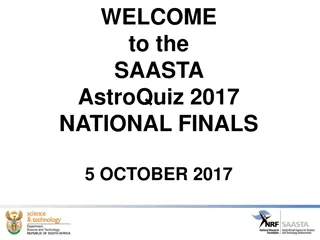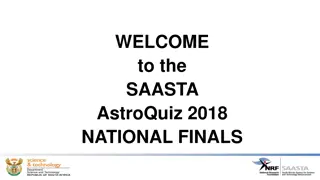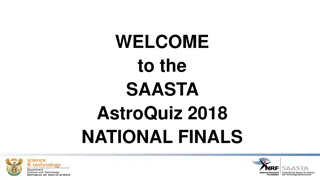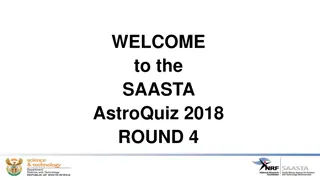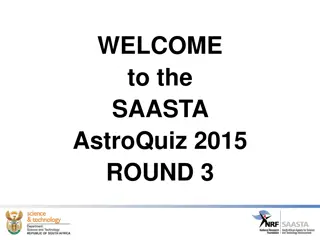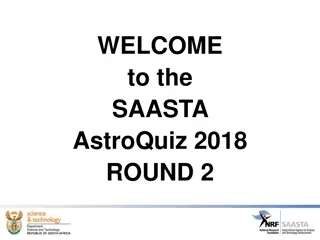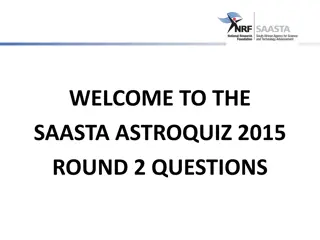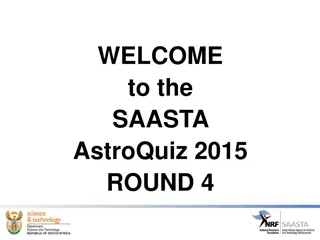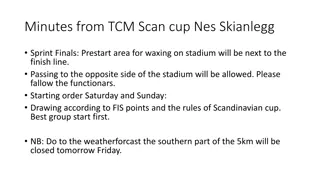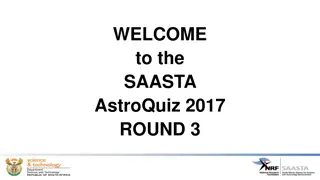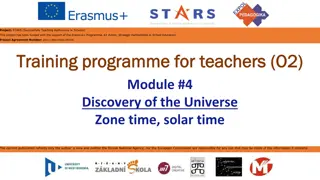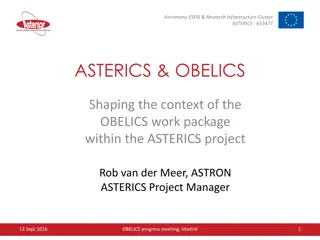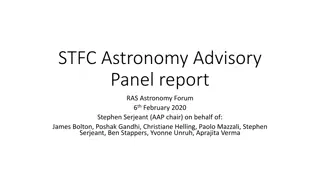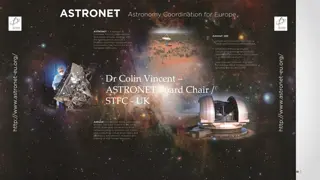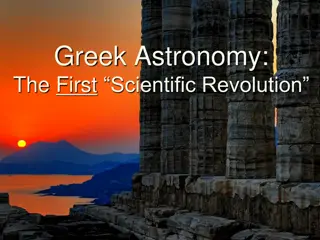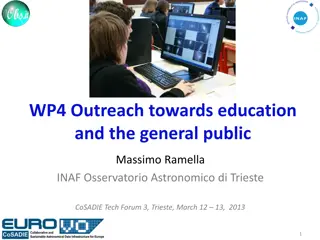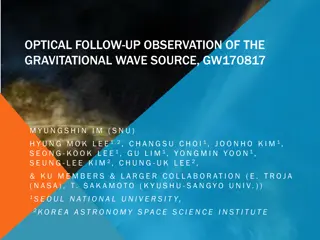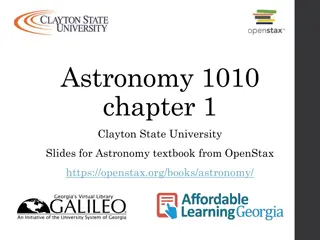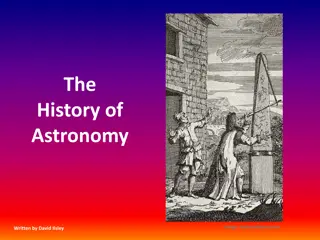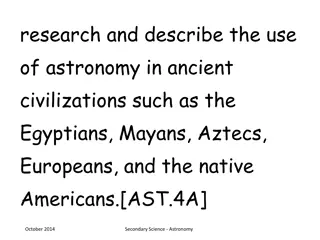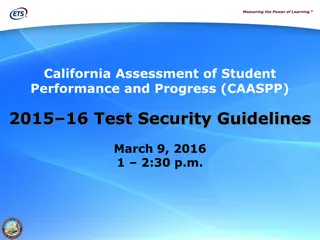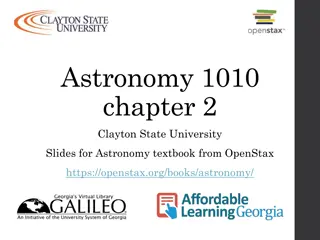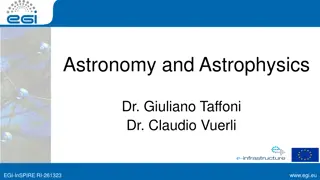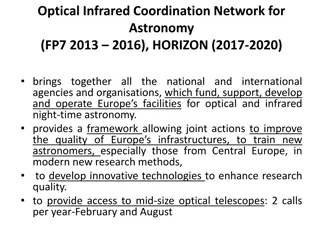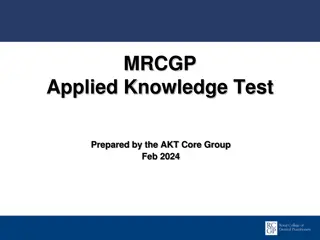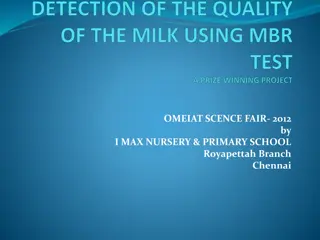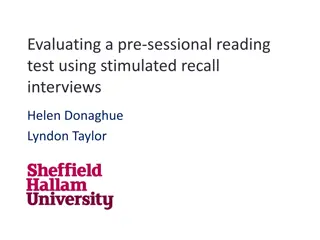SAASTA AstroQuizTM 2015 National Finals - Test Your Astronomy Knowledge!
Get ready for the ultimate astronomy challenge at the SAASTA AstroQuizTM 2015 National Finals. Follow the rules, answer intriguing questions about the Milky Way, Radio Astronomy, Square Kilometer Array, planets, Earth's equator, asteroids, and space missions. Test your knowledge, compete with other teams, and stand a chance to win prizes. How well do you know the universe? Join the quiz and find out!
Download Presentation

Please find below an Image/Link to download the presentation.
The content on the website is provided AS IS for your information and personal use only. It may not be sold, licensed, or shared on other websites without obtaining consent from the author. Download presentation by click this link. If you encounter any issues during the download, it is possible that the publisher has removed the file from their server.
E N D
Presentation Transcript
WELCOME to the SAASTA AstroQuizTM2015 NATIONAL FINALS
RULES OF THE QUIZ The audience must be silent throughout the quiz and NOT whisper to anyone. No resource material can be taken into the quiz venue. Teams have up to 1 minute to discuss each answer and must reveal their answers immediately when the signal is given that the time is up. The scores will be calculated and given after THE FIRST ten questions ONLY and overall winners will be announced at the Awards function in the evening. The audience will get a chance to win prizes! A tie-break will be settled on a sudden death basis, involving tied teams only (i.e. as soon as a team falls behind on correct answers, it is knocked out).
QUESTION 1 The Milky Way Galaxy is best observed from the Southern than Northern hemisphere. A. True B. False
QUESTION 2 Radio Astronomy in Southern Africa started in 1961 with the construction of a facility now known as Hartebeesthoek Radio Astronomy Observatory. A. True B. False
QUESTION 3 The core of the Square Kilometer Array will be situated in the Karoo in the North West province. A. True B. False
QUESTION 4 A. How many terrestrial planets have natural satellites? A. Five B. One C. Four D. Two
QUESTION 5 Temperatures around the equator are on average higher than any other on planet Earth because _____ A. B. The equator is much closer to the Sun The angle of incidence is close to zero degrees from the vertical The equator cuts the Earth at the centre The equator absorbs and retains the heat from the Sun C. D.
QUESTION 6 The biggest asteroid known is ___ A. Vesta B. Icarus C. Ceres D. Eros
QUESTION 7 Which of the following describes Vostok 1 best? A. It is supposed to reach Jupiter and send pictures back to Earth B. It is the first manned space mission C. It is the first spacecraft to take animals D. It is the first spacecraft to disintegrate before reaching space
QUESTION 8 Heliocentric means around ____ A. Jupiter B. The Sun C. Neptune D. Earth
QUESTION 9 Triton, Neptune s moon, has an ocean made of liquid. Which liquid is this? A. Water B. Oxygen C. Nitrogen D. Hydrogen
QUESTION 10 The greatest distance of a plane from the Sun is called its__________ A. Aphelion B. Perihelion C. Helix D. eccentricity
QUESTION 11 Planet Jupiter has a mass that is ____ A. Equal to the combined masses of Earth & Mars B. Equal to the combined masses of Saturn and Pluto C. Equal to the combined masses of Saturn, Neptune & Uranus D. Greater than the combined masses of all planets
QUESTION 12 Which of the planets below have no moons at all? A. Venus & Mercury B. Mercury & Neptune C. Uranus & Neptune D. Venus & Uranus
QUESTION 13 When the Earth is furthest from the sun, what season is it in the Northern hemisphere? A. Summer B. Winter C. Autumn D. Spring
QUESTION 14 On which day of the year does the summer solstice occur? A. June 21 B. Dec 21 C. June 1 D. Dec 01
QUESTION 15 Which of the following is true about Orion? It is__ A. One of the brighter stars in the sky B. A constellation C. The moon of one of the planets D. An asteroid
QUESTION 16 A telescope s magnification refers to its ability to ___ A. Enlarge an image B. Bring an image closer C. Collect light D. Refract light
THE FOLLOWING DIAGRAM SHOWS THE EARTH AT THE DIFFERENT POSITIONS AROUND THE SUN. USE THE DIAGRAM TO ANSWER QUESTIONS 17 - 23. Seasons1.svg
QUESTION 17 Which motion does Path 2 in the diagram represent? A. Earth s rotation B. the Sun s rotation C. Earth s revolution D. the Sun s revolution
QUESTION 18 What kind of an eclipse is represented in the diagram? A. Lunar B. Solar
QUESTION 19 Which Moon phase will usually be seen from Earth when the Moon is in the position above?
QUESTION 20 At which position of the Earth will the Southern hemisphere experience summer? A. B. C. D. 1 2 3 4
QUESTION 21 At which positions of the Earth will there be an equinox? A. 1 & 2 B. 2 & 3 C. 3 & 4 D. 2 & 4
QUESTION 22 Approximately around which date will the Northern hemisphere get its summer solstice? A. 21 March B. 21 June C. 21 Dec D. 23 Sept
QUESTION 23 During an equinox, neither the Southern nor Northern pole is tilted towards the Sun. A. True B. False
QUESTION 24 If your weight on Earth is 50 kg, what would your approximate weight be on the Sun and on the Moon? A. 119 kg (Sun) and 115 kg (Moon) B. 873 kg (Sun) and 39 kg (Moon) C. 1000 kg (Sun) and 960 kg (Moon) D. 1353 kg (Sun) and 8 kg (Moon)
QUESTION 25 The diameter of the Earth is 12 756 km. If a soccer field is 100 m long, how many soccer fields will fit in the Earth s diameter? A. B. C. D. 127,560 12,75600 12756000 12756
QUESTION 26 At 1 000 kilometres per hour, how long would it take a spacecraft to go from Venus to the Sun? (distance between the Sun and Venus =108 x 106 km) A. B. C. D. 4,7 years 107 748 hours 15,2 days 21,1 hours
QUESTION 27 The three nearest stars to the Sun are _ A. Spica, Betelgeuse, Rigel B. Aldebaran, Acturus, Polaris C. Proxima Centauri, Alpha Centauri, Bernard star D. Proxima Centauri, Rigel and Spica
QUESTION 28 The concept habitable zone of a star refers to___ A. The area around a star where the temperature does not change B. The area around a star where there is a possibility of finding liquid water C. The area around a star where human beings are found D. The area around a star where other small stars can be found
QUESTION 29 If the Earth has a radius of 6378 kilometres, what will its circumference (c) be in kilometres? NB: C = 2 r , = 3.14 A. 40053,84 B. 4,0053 x 105 C. 4,0053 x 106 D. 40,0053 x 107
QUESTION 30 Apart from the Moon, which other place in our solar system has been visited by human beings? A. B. C. D. Venus Saturn None Mars
THANK YOU FOR PARTICIPATING
SUDDEN DEATH TIE BREAKERS
PLEASE REMEMBER: The first school to get the answer correct is the winner. GOOD LUCK!
QUESTION 1 The tilt of the Earth s spin axis causes ______ A. the seasons B. day and night. C. the ice on its poles. D. it to sustain life.
QUESTION 2 The brightest star in the sky, Sirius, is/was____ A. Closest to the Earth B. Whiter and hotter than the Sun C. Blue and hot D. Discovered by Robert Innes in 1915
QUESTION 3 Which of the following is the most accurate about seasons? A. Seasons occur because the Sun goes around the Earth and the Moon around the Earth B. Seasons occur because the Earth goes around the Sun C. Seasons occur because the Earth goes around the Sun and its axis is tilted at 23.50to the plane of its orbit D. Seasons occur because the Earth s orbit brings it nearer and further away from the Sun
QUESTION 4 Which one of the following is true? A. A galaxy is made of a few collection of stars held together by common gravity B. None of the stars in a galaxy have common gravity C. Galaxies contain stars only D. A galaxy is a collection of many stars, gas and dust which are held together by gravity
QUESTION 5 Planets in the solar system shine by ____ A. Nuclear fusion in their cores B. Refracting sunlight C. Reflecting sunlight D. b and c above
THANK YOU FOR PARTICIPATING ALL THE BEST!


